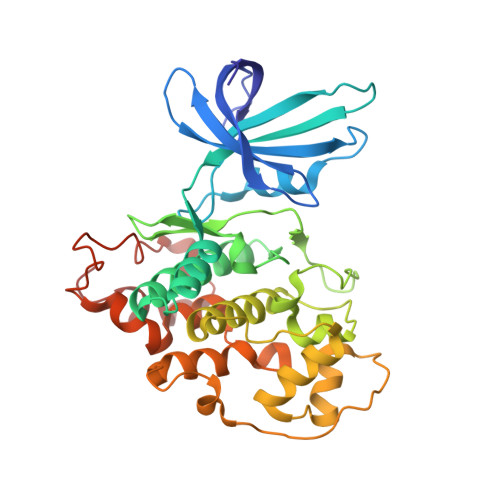Gsk-3-Selective Inhibitors Derived from Tyrian Purple Indurubins
Meijer, L., Skaltsounis, A.-L., Magiatis, P., Polychronopoulous, P., Knockaert, M., Leost, M., Ryan, X.P., Vonica, C.A., Brivanlou, A., Dajani, R., Crovace, C., Tarricone, C., Musacchio, A., Roe, S.M., Pearl, L.H., Greengard, P.(2003) Chem Biol 10: 1255
- PubMed: 14700633
- DOI: https://doi.org/10.1016/j.chembiol.2003.11.010
- Primary Citation of Related Structures:
1UV5 - PubMed Abstract:
Gastropod mollusks have been used for over 2500 years to produce the "Tyrian purple" dye made famous by the Phoenicians. This dye is constituted of mixed bromine-substituted indigo and indirubin isomers. Among these, the new natural product 6-bromoindirubin and its synthetic, cell-permeable derivative, 6-bromoindirubin-3'-oxime (BIO), display remarkable selective inhibition of glycogen synthase kinase-3 (GSK-3). Cocrystal structure of GSK-3beta/BIO and CDK5/p25/indirubin-3'-oxime were resolved, providing a detailed view of indirubins' interactions within the ATP binding pocket of these kinases. BIO but not 1-methyl-BIO, its kinase inactive analog, also inhibited the phosphorylation on Tyr276/216, a GSK-3alpha/beta activation site. BIO but not 1-methyl-BIO reduced beta-catenin phosphorylation on a GSK-3-specific site in cellular models. BIO but not 1-methyl-BIO closely mimicked Wnt signaling in Xenopus embryos. 6-bromoindirubins thus provide a new scaffold for the development of selective and potent pharmacological inhibitors of GSK-3.
Organizational Affiliation:
CNRS, Cell Cycle Group, Station Biologique, BP 74, 29682 Roscoff cedex, Bretagne, France. meijer@sb-roscoff.fr


















